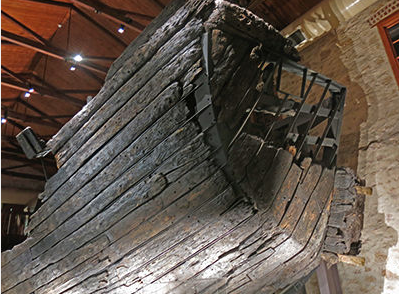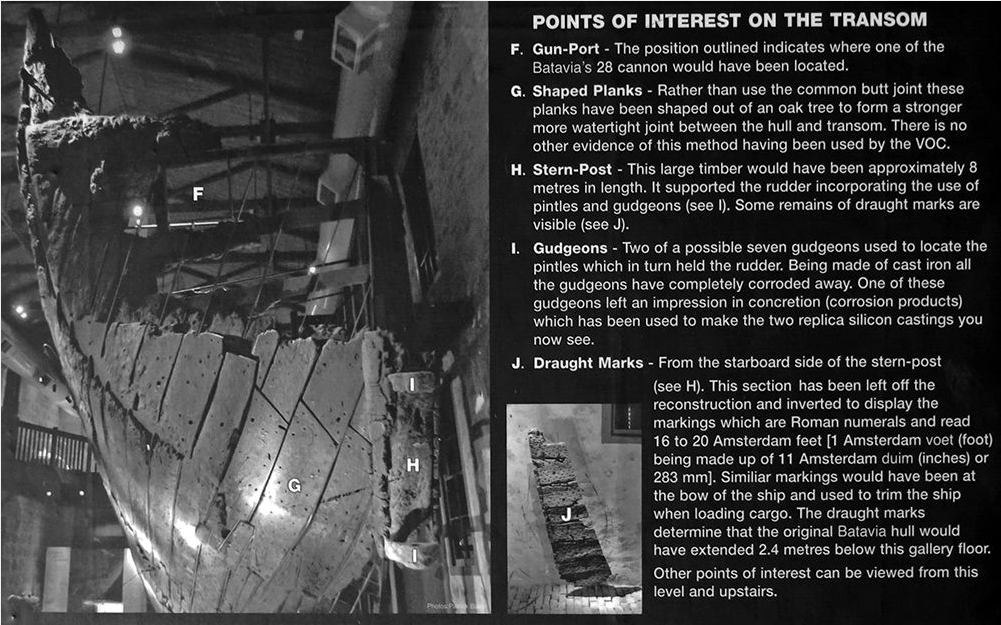-
Posts
7,989 -
Joined
-
Last visited
Content Type
Profiles
Forums
Gallery
Events
Everything posted by Louie da fly
-
It's not a ship model if you haven't bled on it. Welcome to the fraternity . . . Steven
- 536 replies
-
- Quadrireme
- radio
-
(and 1 more)
Tagged with:
-
Though this report is over a year old, I only just came across it - fascinating. I'd like to find out if there's been any result of the survey. https://maryrose.org/news/search-for-sunken-galley?fbclid=IwAR2FZCfW-YD5_LbjfhRGCIloHYMZT4Cs2UGXMsALYaN2WZgP9qrLnoPBKro Steven
-

Greetings from Ontario, Canada!
Louie da fly replied to cdnguy68's topic in New member Introductions
Welcome to MSW, Mark. That longboat in particular is supposed to be a good one to start wooden modelling with. The techniques are quite different from plastic modelling, and it's good to start simple to build up your skills before you move onto more complex builds. Make sure to start a build log - it's the best way to get help and advice, and the rest of us get to see a beautiful model taking shape! Steven -

Another New Guy Introduction
Louie da fly replied to Petes Shipyard's topic in New member Introductions
Struth! That's a long time without building a ship. I'm not sure I'd be able to cope being unable to model for so long! So where are you in SA? From your description of what you're doing, it sounds rural. Do you have any idea which model you're going to work on first? Steven PS: Welcome back. -
Nice work, mate. The railing pieces are really starting to come together. I'm not terribly surprised by the guy's area of study - in the Texas A&M University master and doctorate papers regarding maritime discoveries all come from the Department of Anthropology. Steven
- 756 replies
-
- galleon
- golden hind
-
(and 2 more)
Tagged with:
-
Yes, I believe you're right in doing that. Having all the planks exactly the same width was (from what I've seen) a relatively late idea. Even ships as late as the Mary Rose turn out to have higgledy-piggledy planking. Beautiful work on those curved thwarts, by the way. Steven
- 75 replies
-
- Oseberg
- Billing Boats
-
(and 1 more)
Tagged with:
-

Drafting
Louie da fly replied to mangulator63's topic in CAD and 3D Modelling/Drafting Plans with Software
I had the same problem/realization when I first started working in 3D modelling after many years of AutoCad. The whole mindset is different. As Dr PR put it, you are creating a 3D object in cyberspace. I have to say I far prefer this approach, a any changes you make to the 3d "model" are immediately available in all the orthographic views. Compare this to 2D, where you have to laboriously redraw or at least amend every view - plan, 4 elevations, cross-sections, details etc - to incorporate the changes - so easy to miss one (I worked with house design). After coming across 3D modelling I became very frustrated with the wasted effort and opportunity for error involved in 2D drawing - but the people I worked for weren't prepared to outlay the necessary money to change over to 3D (mind you, one of the principals of one place I worked for, an architect, couldn't even use AutoCad!) Steven -

Hello from Minnesota, a few modeling questions
Louie da fly replied to Scratchie's topic in New member Introductions
Hi Scratchie and welcome. I'd second Allan's recommendation about The Rigging of Ships in the Days of the Spritsail Topmast. Looking at AL's model, it seems to be based on the type of galleon in use in the second half of the 16th century (for example, it has a stern gallery - fairly rare before the end of the century, though I know of a couple of examples from 1555 - but no spritsail topmast). The book starts somewhat later (1620) but it's often possible to extrapolate backwards on the basis that rigging didn't change all that fast. I'm working on a ship from 1545 and this is still the best book I've been able to find, despite it being even further away from my time period than from yours. Another thing you might find helpful is a collection I made of contemporary pictures of galleons on Pinterest - https://www.pinterest.com.au/lowe1847/galleons/ . And you should also check out some of the galleon build logs, particularly Backer's Pelican/Golden Hind - he put a lot of work and research into getting all the details as right as he possibly could (and the model's amazing). Make sure you start a build log - it's the best way to get help and advice, and we get to see a beautiful model taking shape. And have fun with it! -
That's a very beautiful model you're making. I don't know the answer to your question, but the definitive work on rigging for this period is "The Rigging of Ships in the Days of the Spritsail Topmast" by R. C. Anderson, an amazing and deeply researched resource. If that doesn't answer your question, nothing will. I have the book myself, but I can't access it at the moment, otherwise I'd tell you straight away. Best wishes, Steven
-
Just don't carve all your oarsmen out of wood (don't ask me how I know) - Steven
- 536 replies
-
- Quadrireme
- radio
-
(and 1 more)
Tagged with:
-
Welcome to MSW. I do envy you living in Bodrum, with easy access to the underwater archaeology museum, with the Serçe Limanı "glass wreck". Steven PS: You make very nice models.
-
Probably the best way to answer that question is to refer you to the planking articles at https://modelshipworld.com/forum/98-planking-downloads-and-tutorials-and-videos/ Steven
-
Beautiful, crisp work, Jason. It's rather nice to see the woodchips in the hull from forming the mast step, even though I'm sure they'll be gone soon. Somehow makes it more real that you've been working on it. Steven
- 75 replies
-
- Oseberg
- Billing Boats
-
(and 1 more)
Tagged with:
-
Good save, mate! (We've all been there one time or another). Steven
- 179 replies
-
- Second Build
- Pinta
-
(and 2 more)
Tagged with:
-

Mayflower by tj456 - 1/19 scale
Louie da fly replied to tj456's topic in - Build logs for subjects built 1501 - 1750
Nice clean, crisp work, mate. She's looking good. Just a point for future reference, it's better to plank both sides at once, evenly on both sides, rather than plank one side then the other. The forces involved can warp the hull to one side if applied unevenly (don't ask me how I know!). I'm hoping this won't happen to your model. It looks excellent so far. Steven -
Very nice work, mate. She's really coming together well. Steven
- 179 replies
-
- Second Build
- Pinta
-
(and 2 more)
Tagged with:
-

Found this ship in dump
Louie da fly replied to Santa Rogge 1600's topic in New member Introductions
On the contrary, yours was in very good condition for its age. I don't think anybody realised you were asking for help restoring it, as you mentioned planning to get it done professionally. I'll put a reply up on your post - but apart from the loose lanyards for the shrouds, it does look pretty good already. Steven -
Hi and welcome, Phil. If you're doing the model from the movie, I'd suggest you do a google image search for the Black Pearl - that should answer your questions, not only the sails but also the shape and details of the hull. I'd suggest also that you begin a build log for the model you're making - it's a great way to get help and guidance from the members here. Instructions are at Best wishes, Steven
-

Mary Rose – an English ship of the Mediterranean concept
Louie da fly replied to Waldemar's topic in Nautical/Naval History
Waldemar, my understanding is that this technique was not purely Mediterranean - have you seen Brad Loewen's work on Hauling Down the Futtock vs Espalhamento - https://journals.lib.unb.ca/index.php/MCR/article/view/17791/22170 ? Steven -

Found this ship in dump
Louie da fly replied to Santa Rogge 1600's topic in New member Introductions
I agree with Jaager - the value to me is in restoring a model of this type to its original glory, rather than to try to make it "more authentic". I had a similar problem with my Great Harry restoration - I built it back in about 1967 when I knew a lot less, and my restoration is mainly bringing it back to the way it was when I built it, rather than to "correct" things I didn't understand at the time (I have to say I haven't been totally consistent with it, but generally I've tried to keep it to that.) However, as this is Santa Rogge's thread I feel that if we want to continue talking about Keith's build it should go onto his build log from now on. Steven -

Found this ship in dump
Louie da fly replied to Santa Rogge 1600's topic in New member Introductions
I'd vote for sails, despite the problems of having to make new ones and their hiding stuff. That's the way the ship was originally presented, and to be true to her you should probably go that way, though "weathering" the sails to duplicate the patina of the rest of the ship would probably be best. Regarding the rigging, again it would probably be best to duplicate as far as possible the way it was first done. My opinion only, however. Steven
About us
Modelshipworld - Advancing Ship Modeling through Research
SSL Secured
Your security is important for us so this Website is SSL-Secured
NRG Mailing Address
Nautical Research Guild
237 South Lincoln Street
Westmont IL, 60559-1917
Model Ship World ® and the MSW logo are Registered Trademarks, and belong to the Nautical Research Guild (United States Patent and Trademark Office: No. 6,929,264 & No. 6,929,274, registered Dec. 20, 2022)
Helpful Links
About the NRG
If you enjoy building ship models that are historically accurate as well as beautiful, then The Nautical Research Guild (NRG) is just right for you.
The Guild is a non-profit educational organization whose mission is to “Advance Ship Modeling Through Research”. We provide support to our members in their efforts to raise the quality of their model ships.
The Nautical Research Guild has published our world-renowned quarterly magazine, The Nautical Research Journal, since 1955. The pages of the Journal are full of articles by accomplished ship modelers who show you how they create those exquisite details on their models, and by maritime historians who show you the correct details to build. The Journal is available in both print and digital editions. Go to the NRG web site (www.thenrg.org) to download a complimentary digital copy of the Journal. The NRG also publishes plan sets, books and compilations of back issues of the Journal and the former Ships in Scale and Model Ship Builder magazines.





